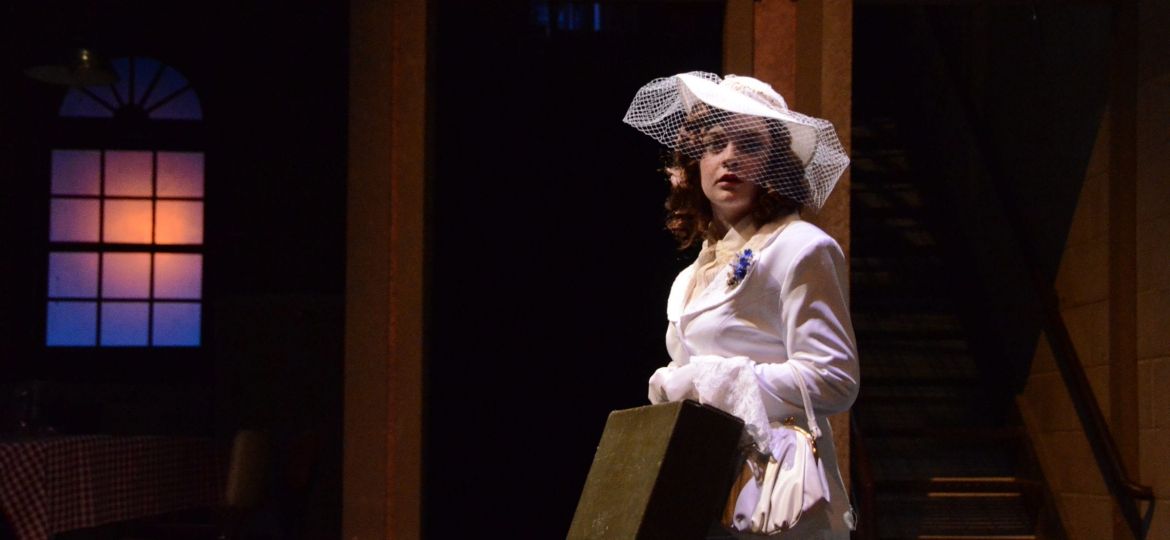
“A Streetcar Named Desire” played in Kelsey Theater on April 12-15. Set in Post-WWII New Orleans, this Tennessee Williams play tells the story of three characters: Blanche (Claire Chenoweth ’20), Stanley (Logan Luiz ’20) and Stella (Rosie Linsner ’18), and their struggle to survive in an unfair world.
The play deals with themes of abuse; the program was sprinkled with content warnings and Sexual Assault Resource Network (SARN) advocates were available for audience members in the lobby. Even with the warnings and support offered, the show was hard to watch at times. People in the audience cringed and covered their eyes, some even started crying. In these moments especially, I was astounded at the sheer talent of my peers as they depicted the most tragic parts of humanity.
During Stanley’s poker night, or “The Party of the Apes” as his sister-in-law Blanche calls it, the play’s fervor escalated. The stage’s back lights switched to a violent red as Stanley dragged his wife, Stella, across the stage and attacked her in their kitchen. I felt the audience  tense beside me as Stanley’s friends pulled him off of Stella, carrying her upstairs. Within moments, Stanley was back at it, shouting Stella’s name into the empty space. I expected Luiz’s interpretation of the famous “Stellaaaa!” quote (made famous by Marlon Brando, who played Stanley in the 1951 film rendition) to be a cheesy impression of the original, but the angry tirade was the pinnacle of Luiz’s performance. The raw emotion grew with each repetition of her name and culminated as Luiz collapsed into tears. The way the audience responded, completely silent at the edge of their seats, was telling of not only Tennessee Williams’s captivating characters, but the passion and realism of Luiz’s performance.
tense beside me as Stanley’s friends pulled him off of Stella, carrying her upstairs. Within moments, Stanley was back at it, shouting Stella’s name into the empty space. I expected Luiz’s interpretation of the famous “Stellaaaa!” quote (made famous by Marlon Brando, who played Stanley in the 1951 film rendition) to be a cheesy impression of the original, but the angry tirade was the pinnacle of Luiz’s performance. The raw emotion grew with each repetition of her name and culminated as Luiz collapsed into tears. The way the audience responded, completely silent at the edge of their seats, was telling of not only Tennessee Williams’s captivating characters, but the passion and realism of Luiz’s performance.
Likewise, Chenoweth and Linsner, playing sisters who couldn’t be more opposite, successfully portrayed the struggles of women trapped between desire and abuse. Linsner almost seemed hysterical in her believable depiction of a powerless character frantically attempting to please the two people she loves the most – her emotionally abusive sister and physically abusive husband. Chenoweth, quite possibly giving the strongest performance of the three, acted with a fierce approach to a headstrong character. This sister was vulnerable to herself and her own tragic past. The trio – Luiz, Chenoweth and Linsner – carried the show with their riveting performances.
“I was astounded with the sheer talent of my peers as they depicted the most tragic parts of humanity.” – Kailey Favaro ’20
The lighting within this play added dramatically to the symbolism behind the story. One way to describe the lighting, designed by Ben Golden, is tension driven. Even with the snowstorm hurling outside the doors of Kelsey Theater, the lighting alluded to the hottest days of summer. Its warm incandescence paralleled the helter skelter occurring onstage. Moreso, the silhouette lighting proved effective in concealing the more provocative elements of the show. In the cases of abuse, it became more compelling that the abuse was hidden in the darkness of the stage. In the cases of sexual tensions, two lovers could lustfully disappear into the silhouettes. The audience didn’t have to see these tense moments to experience the tension behind them.
The set was also impressive. The whole play took place within the tiny New Orleans apartment. The set felt as boxed in as the characters did in their struggles. Rather than the usual Kelsey Theater set up, the audience sat on the stage. This gave the impression of intimacy, but because the stage still held the traditional Proscenium style, the onstage action successfully remained removed from the audience. Because this story deals with issues of abuse and extreme aggression, this physical separation felt extremely necessary. Yet this type of seating created visual issues for the audience; unless one sat in the front, it became difficult to see all the angles onstage.
Overall, “A Streetcar Named Desire” enveloped the audience in its twisted, cruel world. Director Michelle Gibbs didn’t miss a beat in her rendition of the classic, artfully designing each theatrical element to point back to a very raw version of humanity.
Gibbs writes in the Director’s Note, “In a ‘Streetcar Named Desire,’ I set out out to direct a play about a community entrenched in the human experience … their basic instinct to survive and thrive is recognizable and resonants with us, especially in the most tragic of moments.”
favaro1@stolaf.edu











You must be logged in to post a comment.